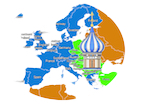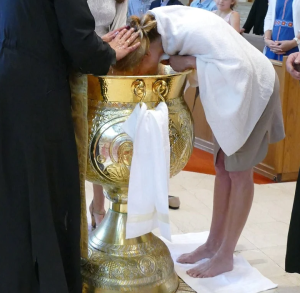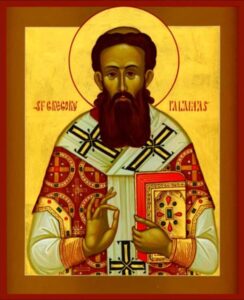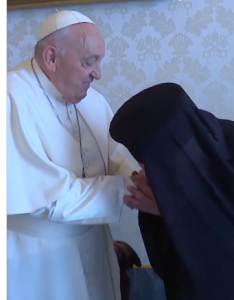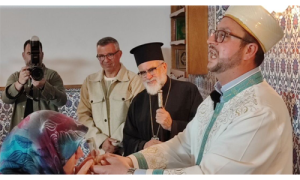The Misuse of the Monastic Fathers’ Expression “The Royal Path”
7 min read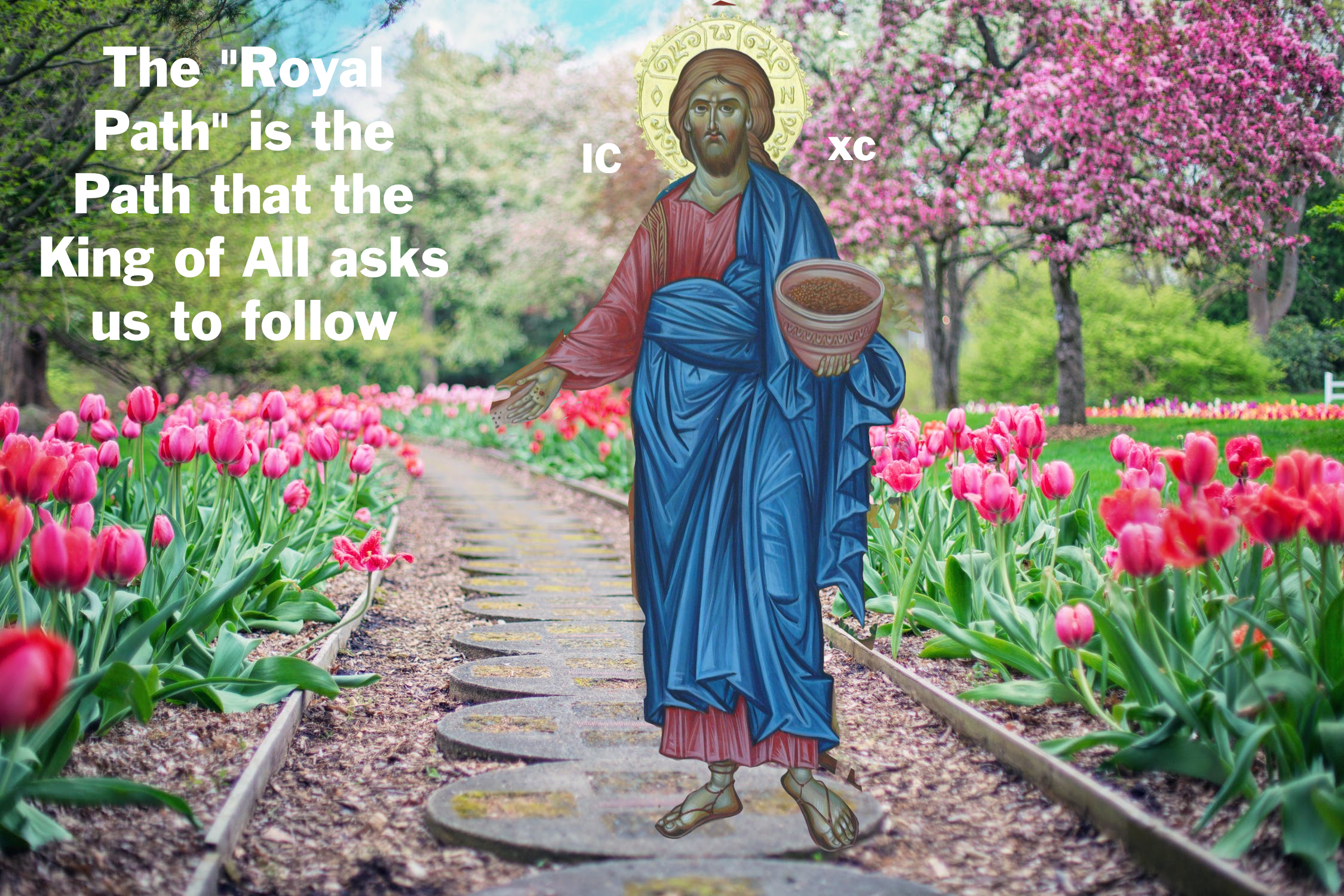
The "Royal Path" is the path that the King, Our Lord, God and Saviour Jesus Christ shows us.
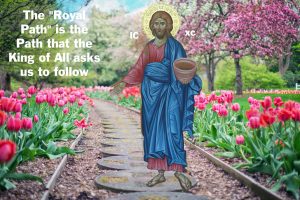
The Misuse of the Monastic Fathers’ Expression “The Royal Path”
by Bishop Philaretos
It is common in today’s world to try and convince someone of your beliefs even if that means purposely manipulating a term or a text in a way that it wasn’t meant to be used. Using a term seems to give importance and an antecedent to a theory. This catachresis of terms is especially misleading in ecclesiastical writings when Patristic expressions are misused and unethical if it is purposefully done. The use of a Holy Canon or Patristic term seems to give an air of truth to a theory. Often though, these Canons and terms are used either incompletely or in a way they were never meant to be used. This confuses the reader and allows him to believe that the Fathers said things that they never really said.
Let’s look at the use of the expression “the Royal Path” and how this term used by the Fathers is not like its present use in many ecclesiastical circles.
General Meaning
In general, and even before it was used in Christianity, the term “Royal Path”, «Βασιλικὴ Ὁδὸς» literally the “Royal or King’s Path” in Greek meant the path that belonged to the king.
The term in ancient times is usually connected to Euclid the Father of Geometry.
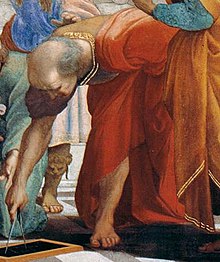
Euclid (Greek: Εὐκλείδης – Eukleídēs), sometimes given the name Euclid of Alexandria to distinguish him from Euclides of Megara, was a Greek mathematician, often referred to as the “founder of geometry” or the “father of geometry”. He was active in Alexandria during the reign of Ptolemy I (323–283 BC).
When Ptolemy I asked Euclid for an easier method to learn geometry, Euclid is said to have responded, “There is no royal path (βασιλικὴ ὁδὸς) in geometry”. Here the meaning is clear that geometry requires struggle and that struggle is necessary even for the king (Ptolemy I).
In the Desert Fathers
Among the Fathers of the desert, this expression was used concerning asceticism. The Fathers warn against extremes in asceticism because attempting too strict an asceticism can give birth to physical ailment (which could be a blessing for some, but for the less spiritually prepared could open the door to leaving asceticism altogether) and too little asceticism could bring a lax in spiritual life. This is how the Fathers used this expression. They urge us to take the “Royal Path”, the path of Christ whose “yoke is easy and burden is light” (Matthew 11:30), and to avoid new paths that can lead to pride and delusion.
Used in having to do with the days of Apostasy
This expression came to be used to speak of a “moderate” way of True Orthodox regarding the state of those “churches” of World “Orthodoxy” that fell into the heresy of ecumenism. In this sense, it was probably first used by Hieromonk Seraphim Rose. I do respect some of the earlier writings of Fr. Seraphim. I’m not sure how much he intended his use of the term to be coined as a new ideology in speaking of matters of the Faith. The worse thing that happened though, is that using a statement of the Fathers in a different context appeared to the more simple as being a statement of the Fathers concerning matters of the Faith and not concerning asceticism as the Fathers meant.
St. Mark of Ephesus speaks with the voice of the Fathers when he says, “There can be no condescension in matters of the Faith”. This is the true “Royal Path” or the way of the King of Kings who tells us “with certainty that until heaven and earth disappear, not one letter or one stroke of a letter will disappear from the Law until everything has been accomplished”. So the “Royal Path” is what Christ asks of His followers. Christ asks of His followers an exactness of Faith. This means belonging to the one ark of salvation which is the one Church which is NOT composed of members ailing in the Faith which means heretics. The Church is composed of right-believing bishops with their clergy and laity.
Even the examples Fr. Seraphim Rose uses are speaking about asceticism. Here is what Fr. Seraphim writes:
The teaching of this “royal path” is set forth, for example, in the tenth of St. Abba Dorotheus’ Spiritual instructions, where he quotes especially the Book of Deuteronomy: Ye shall not turn aside to the right hand or to the left, but go by the royal path (Deut. 5:32, 17:11), and St. Basil the Great: “Upright of heart is he whose thought does not turn away either to excess or to lack but is directed only to the mean of virtue.” But perhaps this teaching is most clearly expressed by the great Orthodox Father of the 5th century, St. John Cassian, who was faced with a task not unlike our own Orthodox task today: to present the pure teaching of the Eastern Fathers to Western peoples who were spiritually immature and did not yet understand the depth and subtlety of the Eastern spiritual doctrine and were therefore inclined to go to extremes, either of laxness or over-strictness, in applying it to life. St. Cassian sets forth the Orthodox doctrine of the royal path in his Conference on “sober-mindedness” (or “discretion”)—the Conference praised by St. John of the Ladder (Step 4:105) for its “beautiful and sublime philosophy”:
“With all our strength and with all our effort we must strive by humility to acquire for ourselves the good gift of sober-mindedness, which can preserve us unharmed by excess from both sides. For, as the Fathers say, the extremes from both sides are equally harmful—both excess of fasting and filling the belly, the excess of vigil and excessive sleep, and other excesses.” Sober-mindedness “teaches a man to go on the royal path, avoiding the extremes on both sides: on the right side it does not allow him to be deceived by excessive abstinence, on the left side to be drawn into carelessness and relaxation.” And the temptation on the “right side” is even more dangerous than that on the “left”: “Excessive abstinence is more harmful than satiating oneself; because, with the cooperation of repentance, one may go over from the latter to a correct understanding, but from the former one cannot” (i.e., because pride over one’s “virtue” stands in the way of the repentant humility that could save one). (Conferences, II, chs. 16, 2, 17.)
Here St. Dorotheus is instructing monks about monastic asceticism. The exact words “Royal Path” aren’t used in the quote in the Book of Deuteronomy but St. Dorotheus uses the words of Deuteronomy about being neither to the left nor to the right to signify the royal path in asceticism. The quote of St. Basil (who was so strict concerning heresy and schism) that an upright heart is one that doesn’t turn away either through lack or excess but follows only the way of virtue. That of course, has nothing to do with matters of the Faith!
St. John Cassian in his Conferences is speaking again about matters of asceticism when he talks about a royal path. In no way does he encourage the Westerners to not have strict dogmatic views as this article might imply. And yes, it is proper that St. John of the Ladder praises St. John Cassian, but again, he is not praising him for a wishy-washy stand on dogmatics, but rather he is praising his instructions to the monastics. When we read the second above quoted paragraph (which probably should have preceded the first paragraph as to point out directly what the saint was speaking about from the beginning), we see that St. John Cassian is speaking about the ascetical excesses; fasting and filling the belly, vigil and over-sleeping, excessive abstinence and carelessness.
Keeping what was handed down to us from the Fathers and the Ecumenical Councils can never be considered an excess.
Fr. Seraphim Rose goes on to say, “Applying this teaching to our own situation, we may say that the “royal path” of true Orthodoxy today is a means that lies between the extremes of ecumenism and reformism on the one side, and a “zeal not according to knowledge” (Rom. 10:2) on the other. True Orthodoxy does not go “in step with the times” on the one hand, nor does it make “strictness” or “correctness” or “canonicity” (good in themselves) an excuse for pharisaic self-satisfaction, exclusivism, and distrust, on the other.”
Now, this teaching of the royal path doesn’t really have anything to do with “our own situation” which is keeping the Faith of the Fathers in a time of apostasy. Yes, one shouldn’t have pharisaic self-satisfaction from canonicity, but the Church doesn’t exist outside of “canonicity”.
This interpretation of the Royal Path, as pertinent to dogmatics, is something that the followers of Metropolitan Cyprian and the Synod he formed based on a new design (belonging neither to the Church and beliefs of the True Orthodox nor in obedience to World Orthodoxy) used to its fullest.
The danger in the use of the term “Royal Path” in talking about true Orthodoxy and apostasy, is that the simple reader is lead to believe that the Fathers stood in the “middle of the road” on dogmatic issues. That they found strict adherence to the matters of the Faith to be going to an extreme. This is precisely the opposite of the truth. When matters of the Faith came up, the Fathers and the Holy Councils chose only the royal path which means obedience to the teachings of Christ and His Holy Apostles. The Fathers didn’t turn to the left or the right but remained on a solid path of following the teachings of truth which is always absolute In this truth there are never excesses because Christ is the Truth and the Church is where truth is, as St. Gregory Palamas assures us when he says, “Those who belong to the Church of Christ are those who are found in the Truth. Those who are not in the Truth don’t belong to the Church of Christ.” Our stand should be that of St. Basil the Great when he tells us, “We must show boldness for the Truth, even if some are scandalized”.
